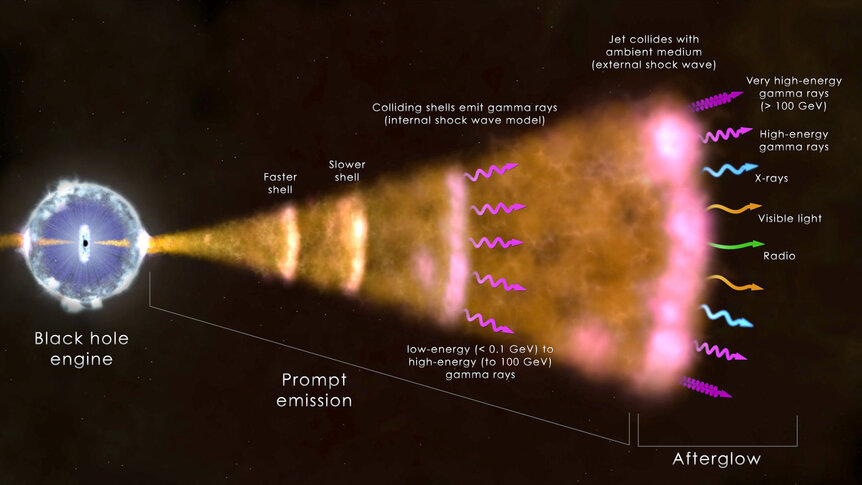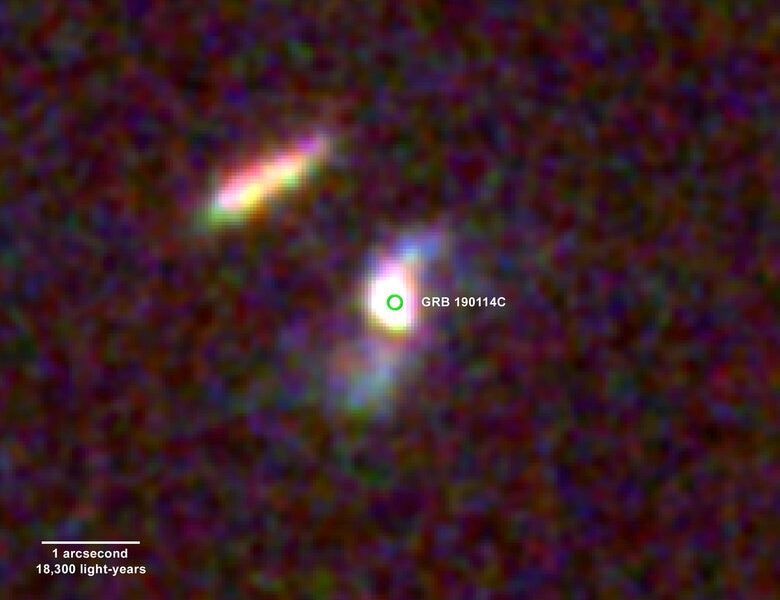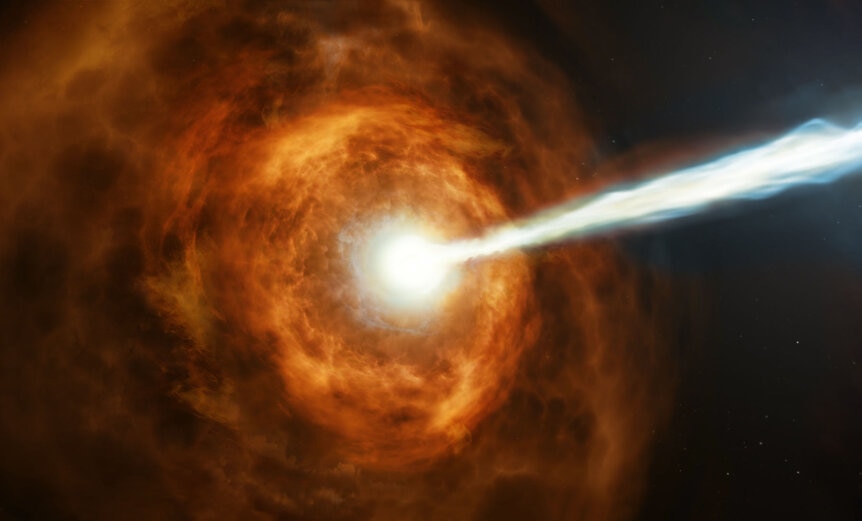Create a free profile to get unlimited access to exclusive videos, sweepstakes, and more!
Two gamma-ray bursts emit highest energy photons ever seen from GRBs

Gamma-ray bursts are pretty much the sweatiest apocalyptic events the Universe has to offer: A blast so ridiculously powerful that, in just a few seconds, it emits as much energy as the Sun will over its entire 10 billion year lifetime.
For two recent GRBs (as those in the know call them) even that wasn’t enough. These two emitted individual photons with the highest energies ever seen. One of them zapped out gamma rays with energies of up to a teraelectronvolt — equivalent to about 500 billion times the energy of photons our eyes detect!
This is important, because astronomers had predicted these kinds of energies could be achieved in GRBs, but it had never been seen before. These observations help us understanding what’s going on not just with the GRB itself, but how the expanding material in one interacts with the environment around it.
There are a few ways to make a GRB, but a common one is when an extremely massive star reaches the end of its life. The details, as you might expect, are just a tad complex, but the important bit is that the core of the star collapses, forming a black hole. Huge amounts of energy are generated in this event, and matter just above the black hole is accelerated to tremendous speed. This creates a shock wave that blasts through the outer layers of the star, giving them so much energy they explode away in a supernova.
But there's more! Deep down, back at the center, material that used to be part of the star’s core swirls around the black hole. This creates twisted magnetic fields of truly unbelievable strength, focused into narrow beams extending away from the poles of the black hole. Through processes still not entirely understood, matter and energy are focused by these fields and shot away at very nearly (and I mean really very nearly) the speed of light. These fierce beams outpace even the shock wave moving upward through the star, eating their way out of the outer layers and erupting outward, away from the star.
That is the gamma-ray burst: An intensely high-energy pair of beams — calling them death rays is not really an exaggeration, as it’s nearly impossible to exaggerate anything about GRBs — that scream outward into space. These beams are so powerful that we can detect them pretty much clear across the observable Universe.
These occur several times a day somewhere in the cosmos, and we can detect them if the beams happened to be pointed at us. Happily, they happen very far away, so we just see them as a blip of gamma rays somewhere in the sky. That usually comes and goes with seconds, but there’s also an afterglow that can last for minutes to even months. This is caused by the jets slamming into material around the star that exploded, dropping unimaginable amounts of energy into it and causing it to glow as well.
That brings us to the two new bursts. GRB 180720B* occurred in a galaxy about 6 billion light years away, a hefty distance. Within seconds NASA’s orbiting Fermi and Swift gamma-ray satellites detected it, and sent out an automated alert to other telescopes to look for it. One of these was HESS (High-Energy Spectroscopic System). HESS doesn’t see gamma rays directly, but is sensitive to the glow in our own atmosphere when these super-high-energy photons slam into the air, moving faster than light in that medium (which is slower than light speed in a vacuum, so no physical laws are broken here). This creates Cherenkov radiation, blue flashes that are like optical shock waves. When HESS sees them it can figure out where the original gamma rays came from, and what their energies were.
It found gamma rays from GRC 180720B that were 440 billion electron Volts (typical visible light photons that we see range from 2–3 eV, so there are extremely energetic photons), the highest ever seen. Incredibly, HESS couldn’t even observe the burst until 10 hours after it occurred, but it detected photons in this energy range for another two hours. So this stuff definitely came from the afterglow and not the burst itself.
These were the highest energy photons ever seen from a GRB… until a few months later, when Fermi and Swift detected GRB 190114C from 4.5 billion light years away. Again, they sent an alert out, and again many telescope swung over to see what's what. One of them was MAGIC (Major Atmospheric Gamma Imaging Cherenkov) which is similar to HESS. But this time, gamma rays with energies up to a trillion eV were seen, more than twice the energy from the other burst!
Photons with energies like this — rather prosaically called Very High Energy (VHE) photons — had never been seen before. The question is: How were they generated?
Astronomers have an idea: inverse Compton scattering. In a nutshell, an electron in space can get hit by a high-energy photon (like a gamma ray) absorb its energy, and get blasted away at high speed. This is called Compton scattering. Sometimes the inverse happens, where a photon gets whacked by an electron that happens to be moving at high speed, and the photons gains energy, pumped up into the gamma ray range.
Electrons like that have to be hugely energetic, and that doesn't happen easily. What kind of event has that kind of energy at its disposal?
Oh, right. A GRB. Those powerful magnetic fields generated by the newborn black hole can catch electrons and whip them up to speeds extremely close to the speed of light. If an already high-energy photons hits one of these really excited electrons, the photon gets even more energy. Voilà! A VHE photon is born.
The only problem is that we can't be sure that's what happened in these two GRBs. It seems likely, but the maelstrom around them is such a mess that astronomers can't be positive this is the mechanism behind these record-breaking bits of light. The good news is that now that we've seen them, it's likely that more will be forthcoming. The more of these seen, the better astronomers will be able to figure out what’s going on.
It's amazing to me that GRBs were only discovered in the 1960s (while trying to see if the USSR was detonating nuclear weapons in space!) and we knew virtually nothing about them until the 1990s. It was then that we had telescopes that could move quickly enough to catch their afterglows before they faded, and we could finally see what was going on. But the launches of Fermi and Swift (the latter was launched on 20 November 2004, so happy 15th, Swift!) ushered in a revolution into observing, categorizing, and truly understanding GRBs. Their abilities, combined with observatories like HESS and MAGIC, are now putting us into a place where we can dig down into the details of GRBs. Watching this field come to maturity has been a scientific pleasure, and I'm always looking forward to what we'll discover next.
*GRBs are named in order of the day of discovery, so GRB 180720B was the second (the first was called A) seen on 20 July 2018.





























